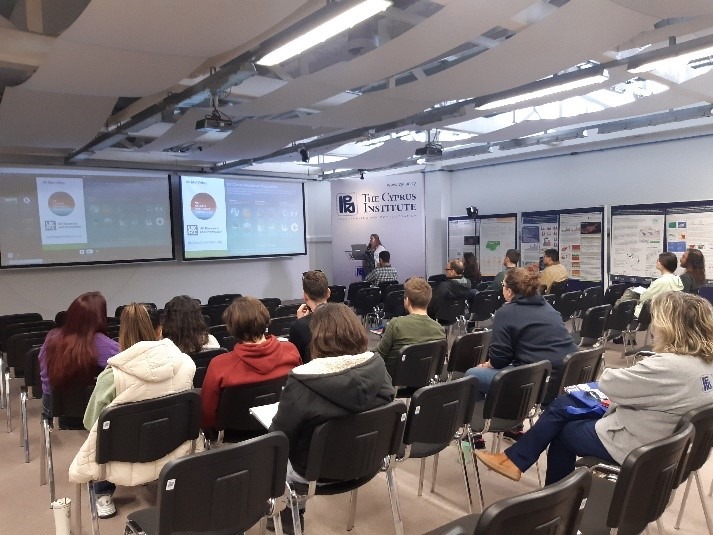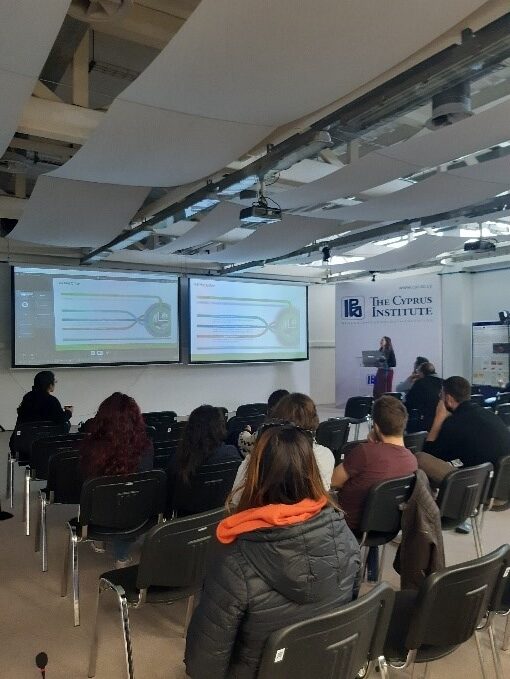
CARE-C of The Cyprus Institute hosted two seminars delivered by Dr. Laura Dawkins and Dr. Freya Garry, from MET UK Office, in the framework of the project “Strengthening Cyprus-UK collaboration on climate change impacts research” supported by the British High Commission in Cyprus
On the 14th and 16th March 2023, CARE-C of The Cyprus Institute hosted two seminars at its premises that were delivered by Dr. Laura Dawkins and Dr. Freya Garry, from MET UK Office with the following presentations:
14/3/2023: Exploring Place Based Climate Risk & Adaptation, Dr. Laura Dawkins, MET Office-UK
16 /3/2023: Developing compound event research for UK climate resilience, Dr. Freya Garry, MET Office-UK
The seminars took place in the framework of the project “Strengthening Cyprus-UK collaboration on climate change impacts research” supported by the British High Commission in Cyprus and leaded by Theo Economou, Associate Research Scientist of CARE-C at The Cyprus Institute.
More information about the topics of the presentations can be found below:
Dr Laura Dawkins: Exploring Place Based Climate Risk & Adaptation
Climate change adaptation decisions often require the consideration of risk rather than the environmental hazard alone. One approach for quantifying risk is to use a risk assessment framework which combines information about hazard, exposure and vulnerability to estimate risk in a spatially consistent way. In recent years, publicly available, open-source risk assessment frameworks have been made available, including the CLIMADA tool. Such tools are increasingly being used in combination with ensembles of climate model projections to quantify risk on climate time-scales, presenting the ensemble spread as a measure of climate uncertainty. As climate models are computationally expensive to run, this quantification of uncertainty derived from the ensemble of projections is often limited by the number of members available.
In this talk, Dr. Dawkins presented a novel framework involving the application and extension of the CLIMADA open-source climate risk assessment tool, demonstrating an approach for overcoming this limitation using statistical modelling techniques. She demonstrated this approach using an idealised example related to heat-stress risk and the impact on physical working capacity in the UK. Following this, she also demonstrated an approach for exploring the uncertainty and sensitivity of risk to the subjective input choices used to represent the hazard, exposure and vulnerability, important for fully assessing plausible outcomes and focusing future research efforts. Finally, Dr. Dawkins presented an approach for using this framework to explore place-based adaptation decision making. In addition, she gave a brief overview of the organisational structure of the Met Office, and highlighted some of the key statistical techniques used within the office.
Dr Freya Garry: Developing compound event research for UK climate resilience
Many impactful weather and climate events include two or more variables (like temperature or precipitation) having high or low values (e.g., hot dry summers), or other types of compound events, such as compounding in time or space, or preconditioning events where one event causes conditions which increase the impact of a future event (Zscheischler et al. 2020). This work has been part of a wider UK programme to improve UK climate risk and resilience understanding and practice (the UK Strategic Priority Fund for Climate Resilience), with a specific focus on furthering the understanding of compound events / multiple hazards across the UK over the past 3 years.
Initial work (Garry et al. 2021) involved case studies of compound hazard events of interest to the UK agricultural sector, including comparing the frequency and duration of compound events now to those projected in 50 years’ time, using high resolution (12 km) simulations from the UK Climate Projections to explore how the frequency and duration of instances of potato blight and thermal heat stress to dairy cattle may change locally under RCP 8.5 emissions forcing. The work combines hazard (temperature and humidity data) with vulnerability (specific threshold exceedance) and exposure (regional dairy cattle numbers/potato growing area) to estimate risk. Regions where most potatoes are grown, and where the potato blight risk is greatest in both the current and future climate, include the East of England, Yorkshire and the Humber and Eastern Scotland. Dairy cattle heat stress (using a temperature-humidity index) is projected to increase by nearly 1000% in South West England, the region with the most dairy cattle. Two examples of projected changes to UK seasons are also shown; UK Climate Projections indicate that the annual probability of cold spring/warm summer conditions will decrease in future, but the annual probability of longer dry/warm summers will increase. The release of this work has significant impact with government stakeholders and media over the following years.
Garry & Bernie (2023) presents a framework for evaluating the relationships between different variables (multi-variate bias). The approach is illustrated using UK temperature and precipitation, using HadUK-Grid observations and two model ensembles (12 and 2.2 km horizontal resolution) of the HadGEM3 regional model used in UK Climate Projections both forced with the same driving conditions. The Pearson correlation coefficients and bias in the coefficient of linear regression are considered separately and combined into a single metric. By considering only days with similar North Atlantic driving conditions using Met Office Weather Patterns we can identify regions with significant differences between the two model resolutions that are attributable to the difference in model resolution and structural design.
Other work under the project which is mentioned in the talk includes a new methodology published to generate big datasets from model data (capability to synthesise large ensembles) to better study extremes and compound events published as Economou and Garry (2022). In addition, some results from a short case study prepared for the National Trust about compound events in a local region of the UK (the Yorkshire Dales) are shown.





